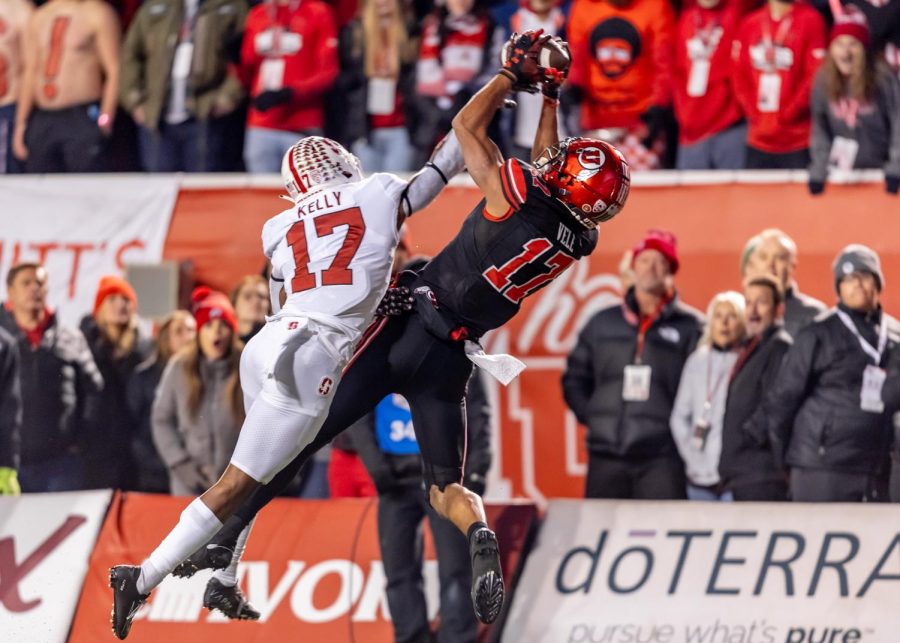What College Football Can Do Better
The University of Utah football team beat the Stanford Cardinal in the NCAA matchup on Saturday, Nov. 12, 2022 at Rice Eccles Stadium on campus in Salt Lake City. (Photo by Jack Gambassi | The Daily Utah Chronicle)
February 11, 2023
A lot will change in the college football world in upcoming years, with the expansion of the College Football Playoff. The format is set to expand to 12 teams in 2024, with Rose Bowl agreeing to participate in the playoffs. Conference realignment will also bring change, with USC and UCLA leaving the Pac-12 for the Big Ten in 2024 and Oklahoma and Texas leaving the Big 12 for the SEC in 2025.
The CFP expanding from four teams to 12 should be a positive change. The reality of the four-team playoff system is that the margin of error to make it into the top four is too slim for the vast majority of teams. Out of the nine years of the playoffs, Alabama has made it seven times. Clemson has made it six times, and Ohio State has made it five times and Oklahoma has made it four times. For the most part, it has been the same teams going to the playoffs every year.
Expanding the playoffs to twelve spots gives just about everyone a realistic chance to make it. The 12-team playoff system will include the six highest ranked conference champions and six at large spots for the best teams who didn’t win their conference. This will be a good system. It reinforces the importance of winning your conference, something that has diminished in the four-team playoff era. It also doesn’t mean winning your conference is everything, as many great teams fail to do so every year. These teams will still get the shot they deserve.
I am looking forward to seeing the twelve-team playoff tournament and how it affects the college football season as a whole. It will make the sport better. I believe there is more that can be done to improve college football. I have always loved college football, but it isn’t perfect.
Something I always hate to see watching a college football game is the targeting rule. It has been a controversial rule since it was introduced in 2008. Targeting can mean a variety of things, but most of the time it is a hit with the crown (top) of the helmet or forcible contact to the head and neck area of the opponent.
The targeting rule is good, in theory. The goal is to increase player safety for both sides. However, lots of the controversy surrounding the targeting rule is that, on top of a 15-yard penalty, a player is ejected from the game if they are called for targeting. If the penalty happens in the second half, the player is also suspended for the first half of the next game. Football is a very fast game, oftentimes, there isn’t anything the defender can do to avoid the penalty.
“[Targeting is] a foul that I appreciate but also can understand the difficulty with having it,” said A.J. Spicknall, a sophomore at the University of Utah. “It’s a call that focuses on the safety and well-being of the players. I have seen both missed targeting calls and accidental hits that have been called targeting. Personally, I like how the call disqualifies a player, but I’d also like a better verification process.”
I think one step to improving the targeting rule is to remove the ejection that’s attached. Removing a player from the game often isn’t fair. It’s too harsh of a punishment and doesn’t help anything. Another change that would help is applying context to the assessment of the rule. When the offensive player is trying to make the catch or is getting tackled, the strike zone for the defender can change quickly. There’s just not enough time for the defender to react. In instances like this, it isn’t right to disqualify the player from the game for something they cannot control.
Another issue in college football is officiating. It is a very difficult job and human error will always be a part of the game, but more can be done to help referees.
“The best change I’d add is if we had a box above that monitors fouls. Refs are human and are very prone to making mistakes,” Spicknall said. “But if there were people [above in the stadium] who’d watch the game but look out for penalties and maintain the rules … this would help when there are hidden fouls or things away from the ref’s eyes”
There should also be a time limit for replay reviews. There are too many reviews that take minutes to determine something you can see right away. It unnecessarily slows down the game. If there was a 60-90 second limit and the referees can’t make a decision in that time, the call on the field should stand.









